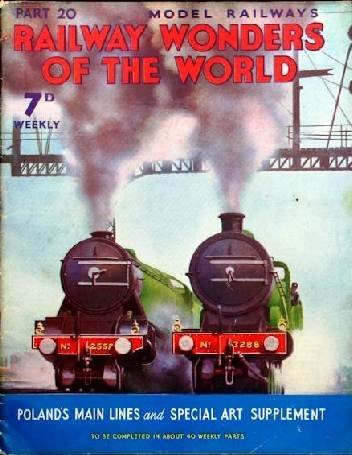
© Railway Wonders of the World 2012-


Part 20


Part 20 of Railway Wonders of the World was published on Friday 14th June 1935.
This issue contained a photogravure supplement featuring Stations from the Air, a further selection of aerial photographs of some British railway stations. The supplement formed the central pages of this issue (pages 627-630).
The Cover
The cover of this week’s issue shows two LNER expresses passing Wood Green. No. 2552 is a 4-6-2 express passenger locomotive named "Sansovino", one of the famous "Pacifics" of the LNER. Many of these "Pacifics" are named after race-horses, and No. 2552 is named after Lord Derby’s horse that won the Derby in 1924. No. 3288 is one of the LNER “Atlantic” class, with a 4-4-2 wheel arrangement. The “Atlantics” are, in spite of their age (which is about thirty years or so), still used with great success for hauling important expresses of moderate weight.
The cover is unusual in having a colour bar at the bottom of the page drawing attention to other articles in the issue.

Contents of Part 20
Editorial
British Diesel Rail Coaches (Part 2)
In this part, the various types of rail-cars in Britain, their comparative speeds and weights, and differences in the power units are fully discussed. The article is concluded from part 19
(Pages 613-620 )
Click on the small image to see a short British Pathe newsreel clip of “Britain’s first streamlined Rail Car”.
Model Railways
Descriptions of extensive organizations run in miniature. Nearly all railway enthusiasts have at some time wished to possess and operate a railway of their own; and this accounts for the large number of Model Railway Clubs that exist all over the United Kingdom. Model railways may vary in gauge from ⅝ in to 5 in or more. This chapter confines itself chiefly to the HO (Half O) gauge. The building of a private system and its equipment are discussed, which will serve as an introduction to this fascinating subject of model railway engineering. A sequel to this chapter appears in part 28.
(Pages 621-626 )
Stations From the Air - 2
A photogravure supplement featuring a further selection of “Stations from the Air”. The locations featured here are St Paul’s and Holborn Viaduct, Glasgow Central Station, and Cannon Street. The first article appeared in part 11, and seems to have been among the most successful of the photogravure features.
(Pages 627-
